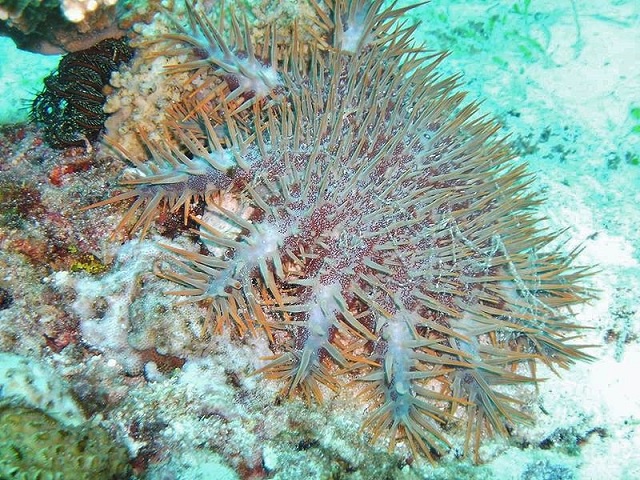A possible solution for Seychelles? Australian robot designed to seek and destroy venomous starfish
(Seychelles News Agency) - Spiky-looking and with few natural predators, the crown-of-thorns (COTS) starfish reproduces like wildfire and eats corals – proving to be a real menace to marine conservation experts who want to protect fragile coral reef environments.
Removing COTS physically from coral reefs is time-consuming, dangerous and costly, and using divers to inject the starfish with poison is only slightly better.
But now a new robotic killer armed with poison might be the answer to solving the problem of COTS, which are swarming and destroying the coral reefs of much of Australia – and perhaps one day in the future the technology could be used to treat other affected regions such as the Seychelles.
Roboticists from the Queensland University of Technology (QUT) have developed an aquatic robot designed to seek out and destroy the coral-killers.
The robot, dubbed the COTSbot by its creators, is autonomous, which means it doesn’t need a human controller; it can identify a COTS and administer an injection of poisonous bile salts into its spiky heart with the very best in computer recognition software.
 |
| The autonomous robot has advanced vision and detection systems, and seeing it targeting its prey is like something out of a video game. (Queensland University of Technology) Photo license: All Rights Reserved |
A press statement issued by QUT said that the COTSbot was given its first successful sea trial last week to test its mechanical parts and navigation system.
More efficient than humans?
The yellow robot is able to do what its human counterparts can and more; it can work underwater tirelessly for around eight hours even in rough weather conditions, and is equipped with enough poison for 200 lethal COTS injections.
"Human divers are doing an incredible job of eradicating this starfish from targeted sites but there just aren't enough divers to cover all the COTS hotspots across the Great Barrier Reef," the robot’s creator, Dr Matthew Dunbabin, said in the press statement.
| Watch: footage of the COTSbot identifying and poisoning the coral-killing starfish with an injector filled with bile salts. (YouTube/Feras Dayoub) Video license: All Rights Reserved |
He added that the COTSbot was viewed as a ‘first responder’ deployed to eliminate the majority of the venomous starfish in a particular area, with human divers following a few days later to take care of any that remained.
"The COTSbot becomes a real force multiplier for the eradication process the more of them you deploy - imagine how much ground the programs could cover with a fleet of 10 or 100 COTSbots at their disposal, robots that can work day and night and in any weather condition."
 |
| The COTSbot can work nonstop, even in adverse weather conditions, for eight hours at a time and is equipped with 200 doses of COTS poison. (Queensland University of Technology) Photo license: All Rights Reserved |
Increased hope for other affected regions
COTS can be found in tropical and subtropical regions of the Indian Ocean as far as the eastern coast of Africa and in the Pacific Ocean up to the coast of Central America.
The coral-killing starfish, protected by hundreds of venomous spines, can be found on reefs between five to twenty-five metres deep and are not commonly encountered in shallow waters. In lower densities, the sea stars can be considered as beneficial to reef environments, but in higher densities they are capable of destroying large sections of hard corals within a few days.
COTS are not new to the tropical Indian Ocean archipelago of Seychelles, where divers first noticed increasing numbers of them as far back as the 1970s.
In the last half of 2014, a sudden increase in the density of COTS was noted in the Beau Vallon area of the main island of Mahe, spreading all the way down the north-western coastline of the island.
An Australian-based environmental consultant named Dr Udo Engelbrecht warned in December last year, that Seychelles must take action in order to prevent reef loss, saying that increased human development coupled with rising sea temperatures had brought about the outbreak.
Since then, a fine-scale survey has been carried out by the Seychelles National Parks Authority (SNPA) to assess the presence of COTS in other areas and try to find the most cost-effective solution to control the problem.
 |
| A delicate operation: until September, the only way COTS could be eradicated in Seychelles was for divers to physically spear and remove them from the reefs, which was a risky endeavour. (Joanna Bluemel) Photo License: CC-BY |
According to an article published in the Seychelles Nation on Wednesday last week, the SNPA was given COTS-fighting equipment by the United Nations Development Fund’s GOS-UNDP-GEF mainstreaming biodiversity project.
The equipment included eight underwater chemical injectors to be used by divers as an alternative to the current control method, which involves physically spearing and removing the venomous starfish and disposing of them in a waste landfill.
The injection equipment will now be deployed by SNPA, NGOs and dive companies in the affected regions.
For now, this is the best option for tackling COTS infestations in Seychelles, but the COTSbot could one day be making its way to the islands.
The robot’s creators at QUT will be seeking private partners to develop the technology further in the hope that it can be produced commercially at a cheaper price.






